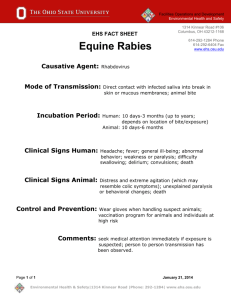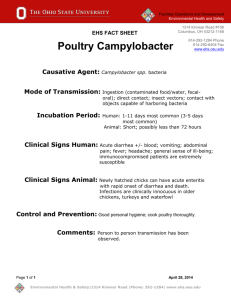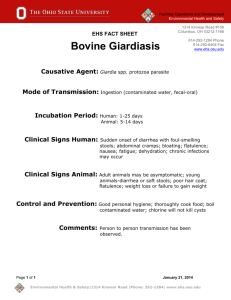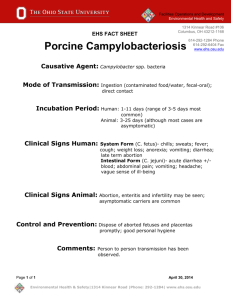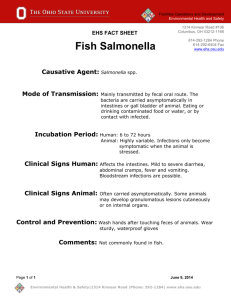Minutes of the Liberal Studies Committee September 6, 2005
advertisement
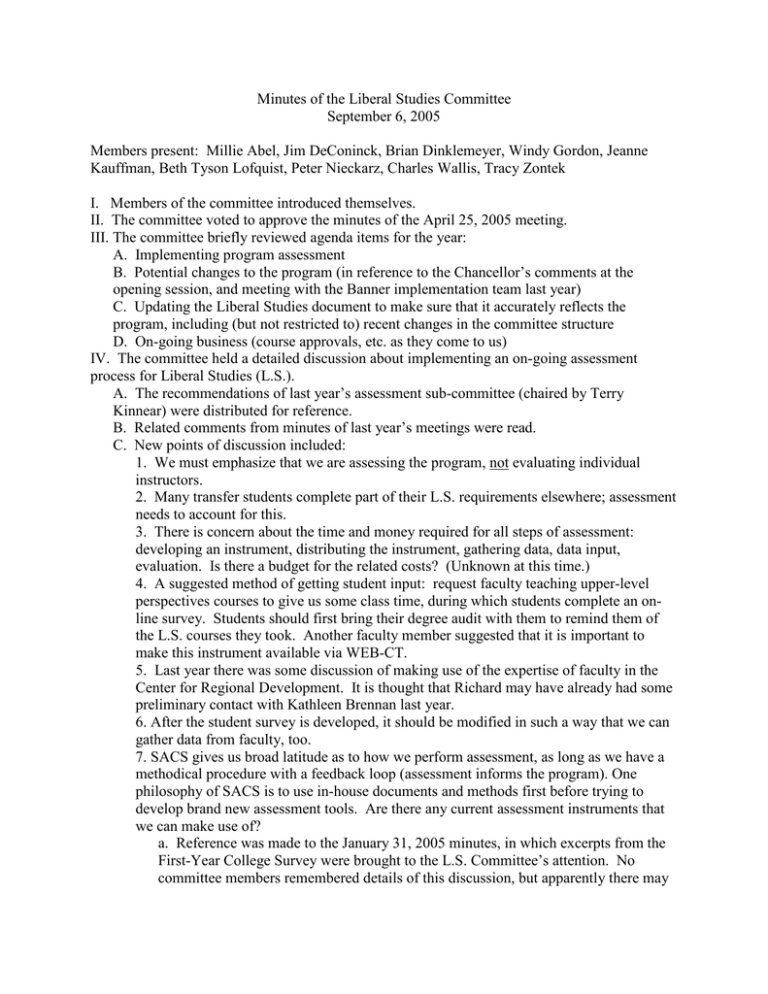
Minutes of the Liberal Studies Committee
September 6, 2005
Members present: Millie Abel, Jim DeConinck, Brian Dinklemeyer, Windy Gordon, Jeanne
Kauffman, Beth Tyson Lofquist, Peter Nieckarz, Charles Wallis, Tracy Zontek
I. Members of the committee introduced themselves.
II. The committee voted to approve the minutes of the April 25, 2005 meeting.
III. The committee briefly reviewed agenda items for the year:
A. Implementing program assessment
B. Potential changes to the program (in reference to the Chancellor’s comments at the
opening session, and meeting with the Banner implementation team last year)
C. Updating the Liberal Studies document to make sure that it accurately reflects the
program, including (but not restricted to) recent changes in the committee structure
D. On-going business (course approvals, etc. as they come to us)
IV. The committee held a detailed discussion about implementing an on-going assessment
process for Liberal Studies (L.S.).
A. The recommendations of last year’s assessment sub-committee (chaired by Terry
Kinnear) were distributed for reference.
B. Related comments from minutes of last year’s meetings were read.
C. New points of discussion included:
1. We must emphasize that we are assessing the program, not evaluating individual
instructors.
2. Many transfer students complete part of their L.S. requirements elsewhere; assessment
needs to account for this.
3. There is concern about the time and money required for all steps of assessment:
developing an instrument, distributing the instrument, gathering data, data input,
evaluation. Is there a budget for the related costs? (Unknown at this time.)
4. A suggested method of getting student input: request faculty teaching upper-level
perspectives courses to give us some class time, during which students complete an online survey. Students should first bring their degree audit with them to remind them of
the L.S. courses they took. Another faculty member suggested that it is important to
make this instrument available via WEB-CT.
5. Last year there was some discussion of making use of the expertise of faculty in the
Center for Regional Development. It is thought that Richard may have already had some
preliminary contact with Kathleen Brennan last year.
6. After the student survey is developed, it should be modified in such a way that we can
gather data from faculty, too.
7. SACS gives us broad latitude as to how we perform assessment, as long as we have a
methodical procedure with a feedback loop (assessment informs the program). One
philosophy of SACS is to use in-house documents and methods first before trying to
develop brand new assessment tools. Are there any current assessment instruments that
we can make use of?
a. Reference was made to the January 31, 2005 minutes, in which excerpts from the
First-Year College Survey were brought to the L.S. Committee’s attention. No
committee members remembered details of this discussion, but apparently there may
be some (limited) data already available from freshmen. Renee Corbin may be able
to serve as a resource.
b. Can L.S. assessment be tied in with the new instructional assessment instrument?
This would be convenient for implementation, but will likely confound the issue of
program assessment (our concern) with teaching assessment (not our concern).
c. Can we take advantage of the senior survey?
8. We must have a methodical approach to evaluate learning outcomes (as summarized
in the Kinnear document).
9. Are individual departments best able to assess whether learning outcomes are being
met? Assessment at the departmental level is a key part of N.C. State’s General
Education Assessment.
10. Perhaps faculty assessment would be most valuable, with student input being
secondary. {Prior to this point in the discussion, the emphasis was on gathering
information from students.}
11. Will it take “badgering” the faculty to get them to give us assessment data?
Response: Recall that courses do not have to meet all L.S. learning objectives. If we (the
L.S. Committee) can develop a matrix in which faculty choose the key objectives of their
classes and explain how those objectives are met, it would take minimal faculty time.
12. The Kinnear document suggests that all L.S. course syllabi be reviewed. Could the
assessment matrix give us the same information (and eliminate the need to review all
syllabi)? (No clear consensus reached.)
13. Even within a single course (with multiple sections), there may be different valid
methods of assessing learning goals: field experiences, portfolios, exams, projects, etc.
The matrix should allow faculty to comfortably document how they meet the particular
learning goals they purport to address.
14. How will this matrix be filled out (considering courses in which there are many
sections, and courses taught by part-time faculty)? It may be difficult to schedule a
meeting among faculty teaching a common course. First response: Each department has
a “curriculum committee” of some type which can oversee the process. Second response:
a physical meeting is not necessary. A “share matrix” which is circulated (or perhaps
posted somewhere) will allow individual faculty members to add their own information at
their leisure. Faculty will not have to reveal themselves by name. Perhaps faculty can
indicate not only how their sections meet learning objectives, but how strongly they feel
objectives are met (lightly, moderately, or strongly emphasized), giving both departments
and the L.S. Committee a weighted measure of how strongly various objectives are met.
15. Recalling that our major assessment data is coming from departments, should we
consider using focus group discussions to gather supplementary data from students?
Some issues to consider related to focus groups:
a. The ideal group size for such a discussion is 6 – 8 people.
b. Concern was expressed about possible self-selection bias introduced by using only
volunteers in the focus groups.
c. An alternative is to use a few upper-level perspectives classes (if faculty will give
us class time). Class size is a drawback, but perhaps each class could be split into
smaller discussion groups.
d. A good moderator MUST keep the discussion on track, and also not let a few
people dominate the discussion.
e. How will the discussions be recorded? L.S. Committee members could pair up: a
moderator and a note-taker. Second response: Ideally all discussions should be
recorded for later review (e.g..video-recorded). Counter-response: This will still
require a transcription. (Followed by another comment about needing a budget for
assessment.)
f. Student focus groups are a useful means of deeper analysis after quantitative data
is analyzed. The method was used successfully at another institution, where
volunteers were provided a nominal incentive ($10 per hour), and students were not
inhibited by video cameras. (Side comment: perhaps we can use pizza and drinks
instead of a cash incentive. Beth responded that she thinks that Academic Affairs
could afford pizza and drinks in its budget for L.S.)
16. This semester we should focus on developing the matrix first, and then we will focus
on gathering student feedback.
17. Is the work of the L.S. Committee itself assessed? So far we are assessing the L.S.
program, and not the work of the committee itself.
Response: The minutes provide documentation of the work of the committee.
18. The Kinnear document discusses such items as enrollment histories. As time was
running short, the discussion of assessment was cut short at this point (to be continued
next week).
D. In summary, the consensus seemed to be that primary assessment data will come from
departments. The L.S. Committee’s first goal is to create an assessment matrix that will be
easy for faculty to use for self-reporting. (Ease of use will be essential to get faculty
involvement). It is also important to gather student feedback as a secondary source of
information, but we (the L.S. Committee) will concentrate on that later. We will also
consider other information mentioned in the Kinnear document.
V. Some closing points were made before dismissal.
A. All members of the L.S. Committee should download a copy of the revised L.S.
document (at WWW.WCU.EDU/liberalstudies) for reference.
B. At the next meeting we will review the rotation of members on the committee.
